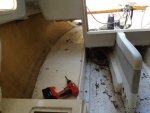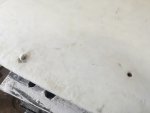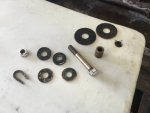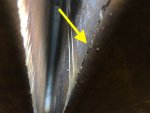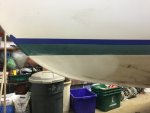Hull Painting Update:
The gelcoat is pretty well shot on this boat and not something that will just buff up with compounding, etc. Some places have worn down through the gelcoat due to exposure and wear. I recall that when I power washed the boat last Fall, the water came off of the boat a chalky white. So, my plan is to re-coat the boat.
I have been thinking about a new color scheme for the boat and looking at some paint samples and different kinds of paint. I do not have the facilities, nor the experience, to do a gelcoating. Although I did re-paint my 1981 Honda Prelude once

. So, my plan is to do a topside paint on the hull sides, deck, cockpit and even the cabin interior. My preference is to use a 2-part polyurethane paint for the base color and then use either a 2-part or even a 1-part polyurethane for the accent striping. I also plan to change the color scheme from
Green to
Blue, as the sail cover is blue, and I'm not thrilled with the green as a color choice.
I got some Interlux paint samples at the boat show recently and have been trying to match up the paint choice as closely to the original color of the boat. It looks like 'Oyster White' in the 'Perfection' paint line is a close match, as the original hull is an off-white color versus a bright white. I will probably use a 'Medium Blue' in the Britesides' line for the accent color. So, it will be a 2-part base and a 1-part accent.
Below the water line will be the barrier coat and a bright white anti-fouling paint.
I also plan on making the top accent stripe a bit wider to add more color to the hull. Currently, the green top stripe is/was about 3/4" and the lower boot stripe is about 2". My plan is to make the top stripe about 3" and the boot stripe about 1". I also thought that I would add a darker blue pinstripe to the top of the 3" wide stripe.
I put together picture of what the boat would look like and will give it some thought. Comments welcome


My plan is also to preserve/replicate the O'Day logo at the stern of the hull. Painting this will be a chore, I'm sure. I plan on using a "roll and tip" method for the hull, deck and cockpit, and may use just a roller on the cabin interior. I want to avoid the hassle of setting up my garage or elsewhere for spray painting.
Thoughts on the scheme and/or painting methods ???




















